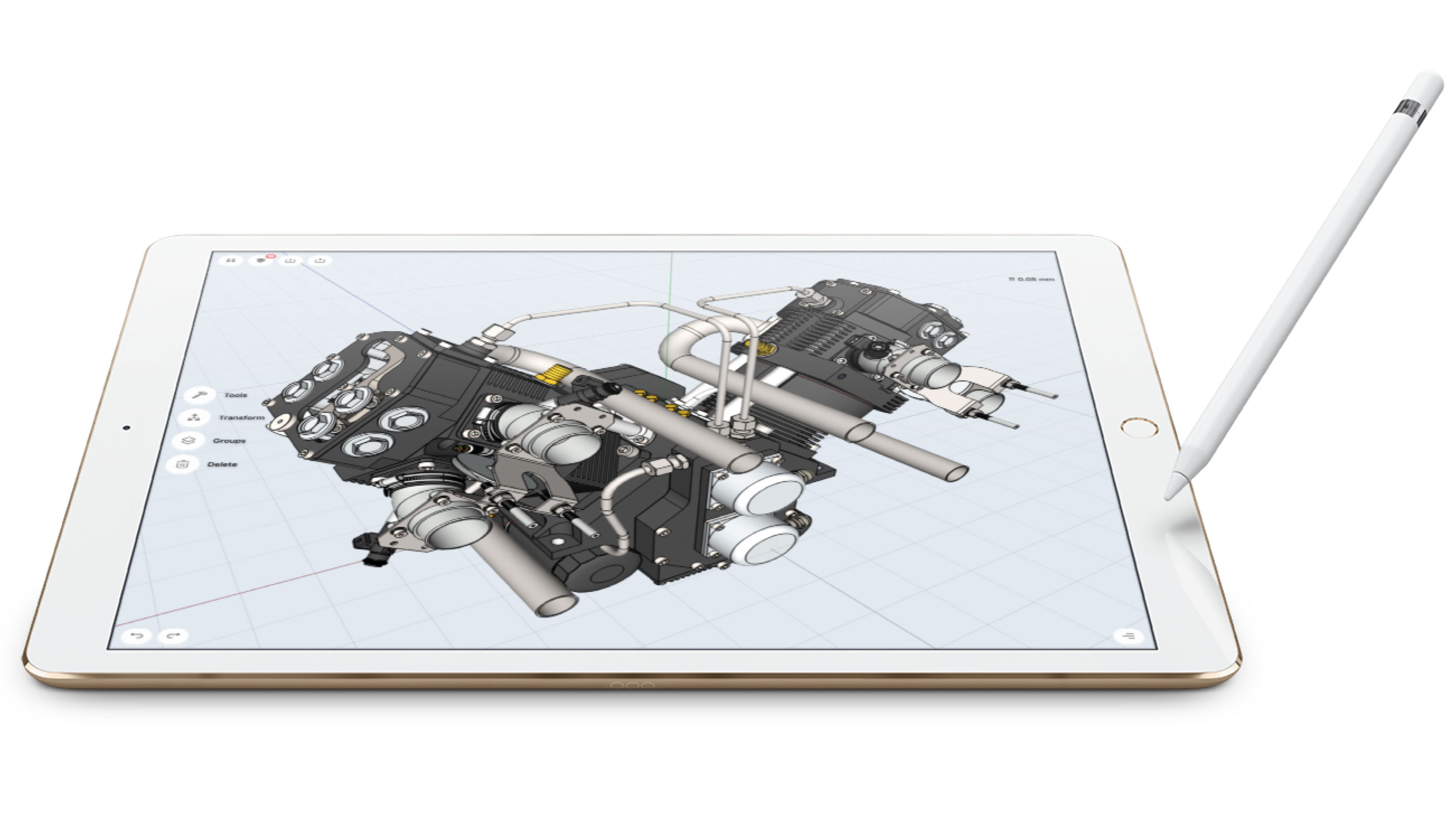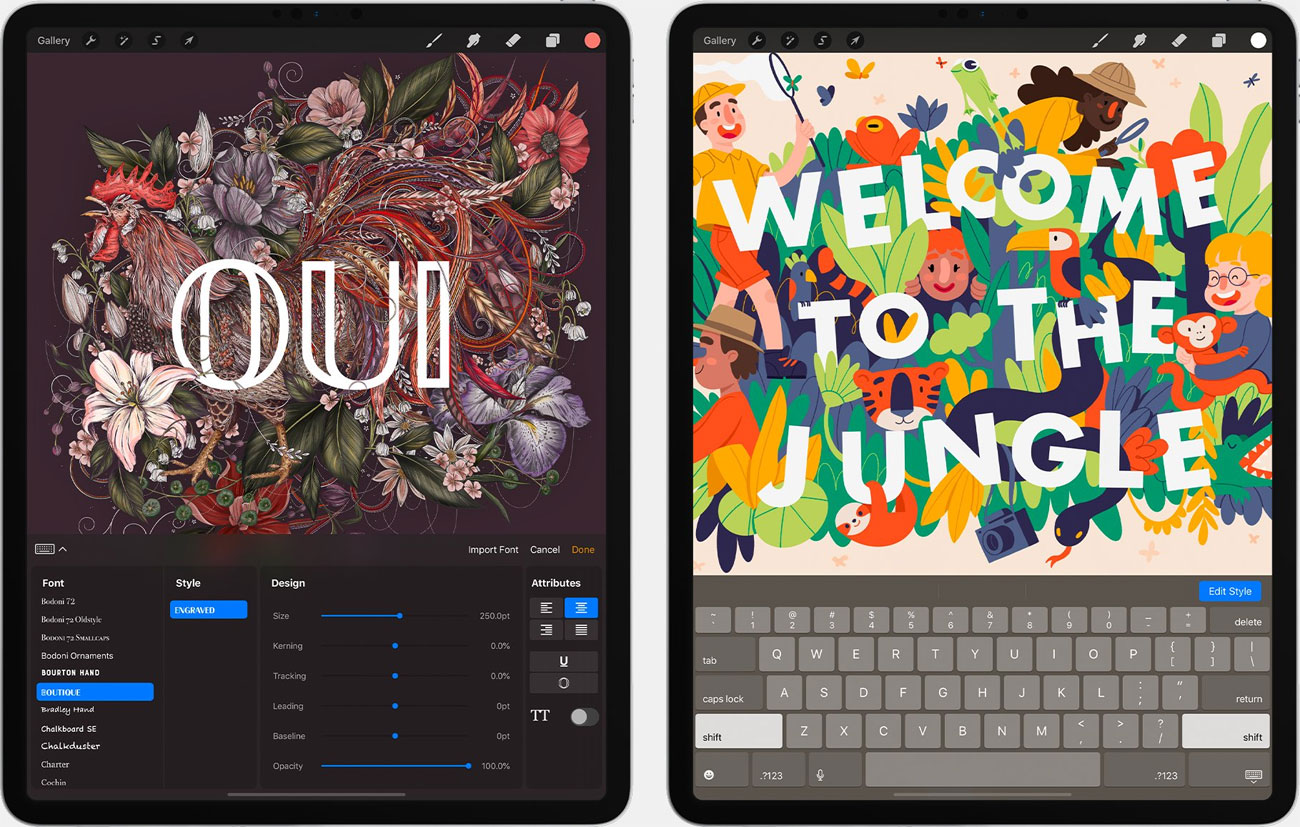Is it possible to turn your iPad into a 3D studio?
3D work on the iPad is easier than ever. But are its apps up to the task?

The holy grail as a freelance artist has always been the ability to work remotely on as light and simple a device as possible. It’s simple logistics: the smaller your device, the less gear you carry, the more accessible you make yourself – and the more likely you are to be hired. Wouldn’t it be great if everything you needed fit into a backpack and was all contained on one device? No peripherals, no extra cables for ports you didn’t expect, no hard drives – just one device that could do everything.
That day may be sooner than you think – and possibly not on the device you would imagine. Conventional thinking would be to explore something like the Wacom MobileStudio, a device that sets out to do just this – give you the full operating power of a PC contained in a single mobile device. However, the hefty price tag may put some off, especially when combined with the cost of licenses for the best 3D modelling software.
One such path is proving to be quite interesting: the iPad Pro. The latest iPad Pro starts at only $769/£769, but can it compete with the processing power of a Wacom? The answer is sadly no, however, that could be less of a stumbling block as it may not require all that raw power anymore to complete the same tasks.
Recently, developments from Apple are allowing much more complex programs such as Shapr3D and Forger to really shine with the use of an Apple Pencil (see our best iPad apps for designers for more great apps). Combined with its generally user-friendly interface, portability and ease of sharing files, the iPad Pro has become a real option for basic remote 3D work.
Here is the challenge we’ll explore – how much of a full 3D pipeline can you realistically recreate using apps on the iPad Pro? We put seven apps through their paces to find out. And that's before you take into account the rumours about the upcoming iPad Pro 2020. But first up, a word on what the iPad isn't.
What can't the iPad do?
The iPad can't do rendering, animation or rigging – so straight off the bat, we are limited to the asset creation portion of the pipeline; we can model, and create artwork and concepts, but that’s where this journey ends.
Sort of. There is surprisingly some limited capability for mocap. Apps like Face Cap (see video above) allow you to use Apple’s front-facing camera as a motion capture device, allowing you to record basic speech and facial expressions. So perhaps the iPad isn't as limited as you might imagine for 3D work. And it's getting better all the time. After all, with the release of Photoshop for iPad, it looks like more and more apps could be getting an iPad-ready makeover.
Daily design news, reviews, how-tos and more, as picked by the editors.
In order to fully release the potential of the iPad, I’ve embraced Apple’s recommendation to use as many of its products as possible, signing up for iCloud storage and linking my other Apple devices (an iPhone X and an older iPad Mini). This is actually the key to this whole enterprise: the iPad alone will not suffice, you need the cloud-based storage to make this workable, not just for its size, but also for its ease of access and shareability.
In addition, syncing my iPhone makes my digital content available to me 24/7 wherever I may be, whether I have my iPad or not, meaning I can remotely download, share, move and store all my files whenever. It also becomes increasingly simple to add supporting content like photo refs and video using the iPhone’s camera and syncing my files automatically – when I turn either device on, bam! There is my content, shared and ready to go.
iPad apps for 3D work
01. Forger
- Price: £9.99
Asset creation is where these apps shine. Forger is a solid substitute for ZBrush, in fact in many cases it exceeds it – not in its overall power or scope of tools and abilities, but certainly in its interface.
It’s designed specifically for the iPad, and so the layout of tools is neatly arranged for you to use your right hand to draw and your left hand for alt keys like the smooth and inverse functions. One of the things I’ve struggled with using ZBrush on mobile devices is its navigation, as you really need to make a custom interface to make it functional on any tablet, with many people resorting to buying Wacom’s ExpressKey tool to make ZBrush easier to use on devices like the Microsoft Surface, which are not specifically designed for it.
Also read: Tips to master ZBrush
02. Shapr3D
- Price: Free (for up to two designs)
Shapr3D's closest equivalent is in fact not Maya, but something more like Moi 3D – however, the developers know its limitations and have totally embraced the gesture and tap-based interface options of Apple’s devices, providing a detailed series of free tutorials on their YouTube channel, and in fact within the app itself. Once you have mastered these, it becomes a surprisingly fast and efficient tool, able to produce accurate and complex geo in mere minutes, often beating the time that would take a more conventional tool like Maya to do.
This app in particular has a dedicated feedback forum, and release updates are frequent and well thought through. Recent additions include a better outliner/geo manager, the ability to import DWG files and convert to usable meshes as well as STL files, and a greatly improved drawing mode. It’s clear that these guys are really looking to corner the market in iPad-based CAD.
03. Photoshop for iPad

- Price: Part of a Photoshop subscription
The full-fat version of Photoshop for iPad, which works exactly like the desktop version without cutting out any features or flexibility, is a rubber stamping of our main argument in this article – that the iPad is now truly powerful enough to act as a substitute for desktop and laptop computers.
Adobe has already produced various graphic design apps for the iPad over the years, all of which have been decent, but ultimately limited versions of the desktop experience. At the heart of this new app is proper support for opening and saving PSD files, with unlimited layers just like on the desktop, adopting a 'pick up where you left off’ system where changes are synchronised via Creative Cloud. You can carry over your edits, brushes and layers from desktop to iPad and vice versa.
While all the desktop tools and functions are available in the iPad version, the user interface has been redesigned for touch-interface use, with heavy use of popover icons, single and double finger tapping and so on.
Some Photoshop veterans have struggled to adapt to this new UI. Much of their skill and speed at editing comes from years of use, with long-engrained muscle memory about keyboard shortcuts and menus that may be lost with this transition to the iPad. Photoshop for iPad may therefore find it hard to establish itself on tablets in the same way it has on desktop computers, and instead may become just another tablet graphics app, competing hard against other tools.
See our full Photoshop for iPad review for more info.
04. Procreate

- Price: £9.99
I’ve been using Procreate to add the finishing touches to anything I’m exporting out of Forger or Shapr3D. Effectively it’s a substitute for Photoshop, and works as my primary application for concept work. Once again this app has been designed with the iPad Pro specifically in mind, and it has an incredible amount hidden under the hood. So much so, that I would thoroughly recommend attending one of Apple’s free lectures at your local Apple Stores on getting up and running in this app, because it really is one of the best drawing apps available. It enables you to add colour layers, import photos, blend textures in and customise brushes to create a very effective paintover and complete a concept, ready to show to clients.
05. Heges
- Price: Free (offers IAPs)
One of my favourite uses of this bridge is the app Heges, which utilises the iPhone X’s front-facing camera to create instant 3D scans of your face (you can also run it on an iPad Pro). As a workflow example, I can scan anyone I meet on the iPhone, upload it to the cloud (these files are large) and download it onto a 3D viewer on my iPad such as emb3d.com, where I can convert into an OBJ and load into Forger.
06. Affinity Photo

- Price: £19.99
On the Mac and Windows, Affinity Photo is a highly affordable alternative to Photoshop, a great way to avoid Adobe’s subscription plans with a modest one-off purchase fee. The same applies to the iPad version. (See our post on the best Photoshop alternatives for more options.)
But what’s really great about Affinity isn’t its affordability, but how truly powerful it is. It can do every advanced thing that Photoshop can, and gives you just as much control. That includes stacking bazillions of layers together, working with Raw files and batch processing. If you can think of anything you need, you’ll probably find it’s possible with Affinity. And just about everything from the desktop version is available too.
Serif also has the iPad version of Affinity. Save an Affinity document on a Mac and open it on an iPad (or vice versa) and you can pick up right where you left off, with the same brushes, masks, layers, and so on.
With so many features, the Affinity iPad interface is deep and complex, and it isn’t a program that a beginner will likely be able to easily master in a short space of time. But the relatively low price of such a powerful tool means that there’s no real excuse for graphics professionals of any discipline to not keep this tool on their iPad.
07. Pixelmator

- Price: £4.99
If Affinity Photo is the iPad’s answer to Photoshop, then Pixelmator is perhaps more akin to Photoshop Elements. That’s not a criticism, Pixelmator is also capable of powerful editing and can be used to create multi-layered images from the ground up.
It's been designed to cater for advanced mobile photography more than graphic art. Pixelmator is naturally also available for the iPhone, with an interface that’s more beginner-friendly than that of the iPad-only Affinity. It has over 100 brushes, effects and filters, colour adjustments, painting and selection tools, but these are primarily aimed at retouching existing photos. In this way, anyone who is serious about mobile photography can easily create something that looks very impressive, add graphics or text to photos, turn them into collages, flip, rotate and transform them, touch up and enhance them.
The interface and beginner-friendly nature of Pixelmator shouldn’t fool you though. Its engine can perform some powerful but subtle edits to images. Light processing can be done with just a few taps, making it possible to perform complex adjustments (such as lowering reflections on an object) without diving into too many settings.
It’s also been around for some time now. Pixelmator is one of the most mature graphics tools on iOS, and performs spectacularly. Notably, a new iPad-only app called Pixelmator Photo has just launched this year, with even more high-end photo editing tools that take advantage of modern iPad hardware such as machine learning, but even fewer features for creating images from the ground up.
We see no reason why Pixelmator and Affinity cannot coexist. They cater for two markets of mobile users, and at their low prices (compared with desktop image editing software), there’s no reason not to own both.
Is an iPad better than a Wacom?
The conclusion here for me is simple: this setup cannot do what a Wacom MobileStudio can. Without the processing power to fully animate and render, it will remain quite limited. However, with more and more of these types of apps coming out, I don’t think that day is very far off.
At less than half the price of a Wacom MobileStudio, it’s just much more accessible, and it’s fun to use! I would honestly recommend downloading all these apps now, or splashing out on an iPad Pro if you don’t already have one, as it’s a great substitute if you want to conceive ideas, or just practise your modelling/sculpting skills.
When you have the ability to create ideas and model/sculpt on the go, and then download those concepts to a more powerful machine to render out stills in software such as KeyShot, it becomes a hugely powerful tool – you can always be producing artwork without the restrictions and confines of a studio or office. Since adopting this workflow, I’ve found myself creating more and the simple truth is, it’s just much more accessible to your everyday life. Give it another year, and who knows what will be possible?
An edited version of this article first appeared in issue 254 of 3D World, the leading magazine for CG artists. Buy issue 254 or subscribe to 3D World.
Read more:

A writer and editor dedicated to helping audiences achieve more with technology, Orestis is a veteran from the days of the 8-bit ZX Spectrum. He is always interested in the fastest, slickest way to make computers do new and exciting things.
